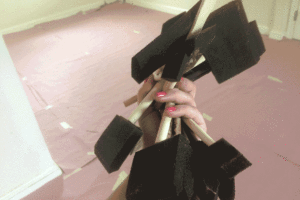 Ever since I heard about concrete counters I have been itching to try them for myself. The only problem was that I didn’t have any counters to try it out on!
Ever since I heard about concrete counters I have been itching to try them for myself. The only problem was that I didn’t have any counters to try it out on!
But now that we bought Main Street House, I have four tries to get really good at it. The apartment above the garage will be the first test where I’ll try it in the bathroom and then move onto the kitchen. If I like the look, I’ll go ahead with doing it in the main house’s kitchen and bathroom (and maybe even our future 2nd bathroom if all goes well!).
I’m in the beginning stages of research but I thought I’d share what I found so far, and if you have anything to add, leave it in the comments or shoot me an email.
And not to worry, once I’m done with my first (hopefully) successful concrete countertop I’ll post a detailed tutorial on exactly how I did it. You’ll benefit from my mistakes (hopefully not too many), my tips on what I’d do different next time and step by step pictures.
As for my research on how to make concrete countertops…
My first entry for good old google was “how to make a concrete countertop.” Of course the first thing that popped up was a post from DIYnetwork, which was a little technical but I got the gist of what to do (check that out here).
The “gist” I got for how to make your own concrete countertops was this:
- Measure measure measure, and then measure again. All this measuring is crucial because it’s for the mold that will shape the new counter.
- Create the mold using 3/4″ melamine-coated MDF boards. Caulk all the sides and any cutouts for sinks with silicone caulk.
- Because concrete is heavy, a frame made of 2×4’s should be made to support the weight of the concrete (10-15 pounds per square foot!)
- Cut galvanized structural stucco wire to the mold’s shape, keeping it 1″ smaller all the way around.
- Mix the concrete and add any color pigment and pour into the mold about halfway.
- Add the wire.
- Pour the rest of the concrete, tamping along the way to ensure it’s uniform.
- Smooth the service with a trowel and then use an orbital sander (without paper in it) and hold it on the mold to shake out all the air bubbles.
- Cover with plastic and let it cure for at least a week.
- Remove the mold and going from a 100 grit sandpaper to a 220 grit, sand the entire surface and edges.
- Etch the concrete with a solution of muriatic acid and apply a concrete sealer.
That’s a long “gist” but that’s what I’ve learned so far about making a concrete countertop. However, there are soooo many different ways to create concrete countertops that maybe this isn’t even the best approach to take. Only more research and trial and error will tell.
But then I had another question for google…
How Do I Install an Undermount Sink with Concrete Counters?
I was mainly worried about whether you had to prep something on the concrete mold prior to pouring the concrete but from research it seems like you aren’t supposed to rely on the concrete to hold the sink, so it needs it’s own support.
I found myself on this website and figured out there are a few different ways you can support the sink.
Support an UnderMount Sink With Concrete Countertops
To support an undermount sink with concrete countertops you can do any of the following:
- Buy a commercial bracket, usually sold at granite supply companies. They are installed onto the actual cabinet frame.
- Make a custom wood frame that mounts to the cabinet walls.
- Make a plywood shelf that the undermount sink can drop onto.
I’ve been reading that the skill level needed for DIY concrete countertops is pretty high, but I’m going to go for it anyway. Through other research on granite counters I found that concrete countertops can actually be more expensive to have made and installed than granite, probably because of the level of customization and the time needed to create accurate and strong molds.
Still want to read more about concrete countertops?
Here are some more tutorials on how to make concrete countertops that were really helpful for my research:
Here’s one from blogger Kelly Moore.
Here’s a concrete countertop tutorial from the Imperfectly Polished blog.
And here’s yet another great resource for making your own concrete countertops.
Now I’m off to research what color to add to my concrete! Don’t forget to let me know if you have any other useful information… and check back for my detailed tutorial on how to make your own concrete countertops.





